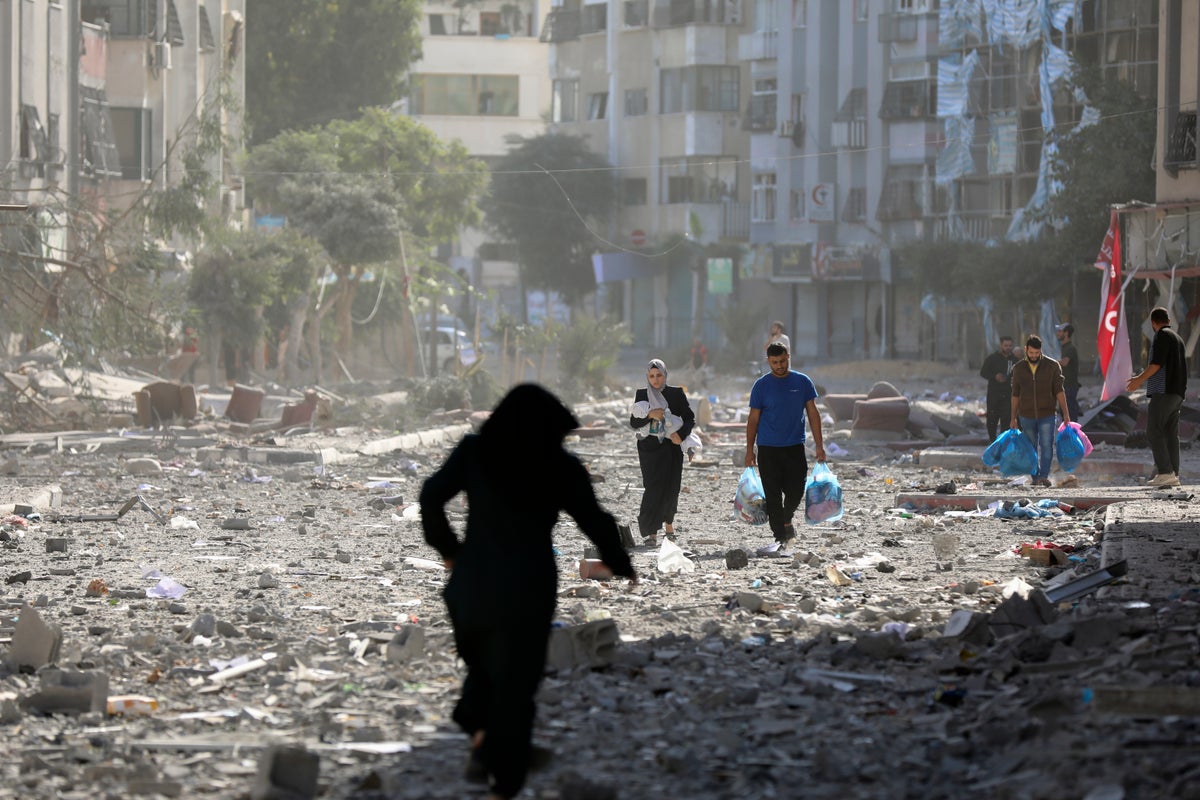
Israeli ground forces attacked Hamas militants and infrastructure on Tuesday in northern Gaza, which the military said some 800,000 people have fled since the war began more than three weeks ago, even as warplanes continued to strike from end to end of the sealed-off territory.
Buoyed by the first successful rescue of a captive held by Hamas, Prime Minister Benjamin Netanyahu has rejected calls for a cease-fire and again vowed to crush the militant group's ability to govern Gaza or threaten Israel following its bloody Oct. 7 rampage, which ignited the war.
The military said one of the estimated 240 captives seized by Palestinian militants during the wide-ranging assault was rescued in a special forces operation, lending support to Netanyahu's contention that the ground war will help facilitate the recovery of more hostages rather than putting them in increased danger.
The army said Pvt. Ori Megidish, 19, was “doing well” and had been reunited with her family.
Hamas has released four hostages, and has said it would let the others go in return for thousands of Palestinian prisoners held by Israel, which has dismissed the offer. Hamas released a short video Monday showing three other female captives.
More than half the territory's 2.3 million Palestinians have fled their homes, with hundreds of thousands sheltering in packed U.N.-run schools-turned-shelters or in hospitals alongside thousands of wounded patients. Israeli strikes have hit closer to several northern hospitals in recent days, alarming medics.
Jonathan Conricus, an Israeli military spokesman, said ground operations are focused on northern Gaza, including Gaza City, which he said was the “center of gravity of Hamas."
“But we also continue to strike in other parts of Gaza. We are hunting their commanders, we are attacking their infrastructure, and whenever there is an important target that is related to Hamas, we strike it," he said.
Larger ground operations have been launched both north and east of Gaza City, which before the war was home to over 650,000 people, a population comparable to that of Washington, D.C.
Video footage released by the military showed soldiers walking across an open area as heavy gunfire echoes in the background and setting up a position in the ruins of a heavily damaged building.
Conricus said some 800,000 people have heeded the Israeli military's orders to flee from the northern part of the strip to the south. But tens of thousands of people remain in and around Gaza City, and casualties are expected to mount on both sides as the battle moves into dense, residential neighborhoods.
The military said it struck some 300 militant targets over the past day and that troops had engaged in several battles with Palestinian militants armed with antitank missiles and machine guns. Hamas' military wing said it fired mortar rounds at Israel forces near a closed border crossing between Israel and Gaza in the southern end of the territory. It was not possible to independently confirm the reports.
In a news conference late Monday, Netanyahu rejected calls for a cease-fire to facilitate the release of captives or end the war, which he has said will be long and difficult. “Calls for a cease-fire are calls for Israel to surrender to Hamas,” he told a news conference. "That will not happen.”
Netanyahu, who faces mounting anger over Israel's failure to prevent the worst surprise attack on the country in a half century, also said he had no plans to resign.
Gaza's humanitarian crisis is meanwhile continuing to worsen, with supplies of food, medicine, water and food running low because of a near-complete Israeli siege.
The U.N. agency for Palestinian refugees, known as UNRWA, says nearly 672,000 Palestinians are sheltering in its schools and other facilities, which have reached four times their capacity. Thousands of people broke into its aid warehouses over the weekend to take food, in what it said was a sign of growing civil unrest.
UNRWA head Philippe Lazzarini accused Israel of “collective punishment” of the Palestinians, and of forcing their displacement from northern Gaza to the south, where they are still not safe.
The death toll among Palestinians passed 8,300, mostly women and children, the Gaza Health Ministry said Monday. The figure is without precedent in decades of Israeli-Palestinian violence. More than 1.4 million people in Gaza have fled their homes.
Over 1,400 people have died on the Israeli side, mainly civilians killed during Hamas' initial attack, also an unprecedented figure. Palestinian militants have continued firing rockets into Israel.
The World Health Organization said two hospitals have been damaged and an ambulance destroyed in Gaza over the last two days. It said a strike near the Al-Quds Hospital in Gaza City sent debris and dust pouring into the facility, which is packed with patients as well as thousands of displaced people.
It said all 13 hospitals operating in the north have received Israeli evacuation orders in recent days. Medics have refused such orders, saying it would be a death sentence for patients on life support.
Israel says it targets Hamas fighters and infrastructure and that the militants operate among civilians, putting them in danger.
Israel has allowed more than 150 trucks loaded with food and medicine to enter Gaza from Egypt over the past several days, but aid workers say it's not enough to meet rapidly growing needs. The Israeli government said in a statement that all deliveries are inspected by Israeli forces, and that “should it become clear that they have been taken by Hamas, they will be halted.”
Israel says it has reopened two main water lines in Gaza, but the U.N. office for humanitarian affairs said one of them had stopped working after operating for two weeks and that the other one was in need of repairs.
___
Magdy reported from Cairo.







